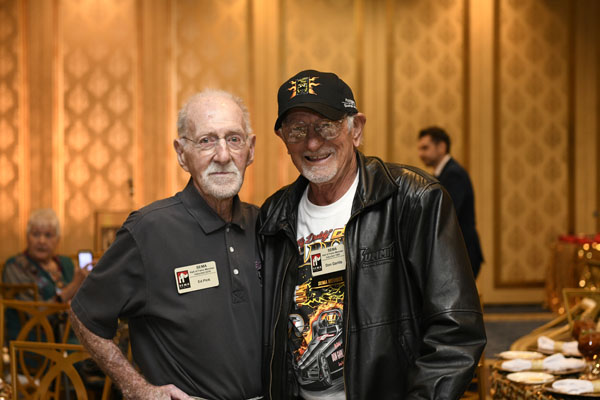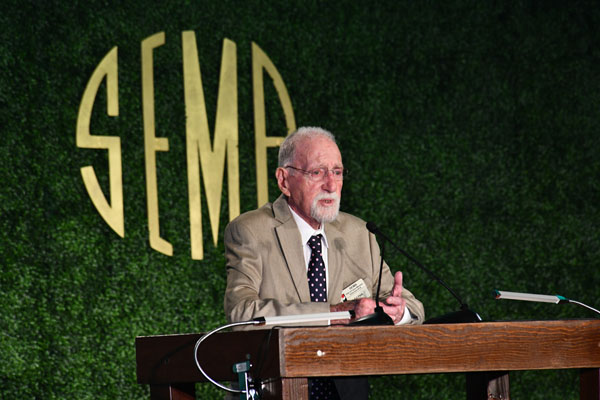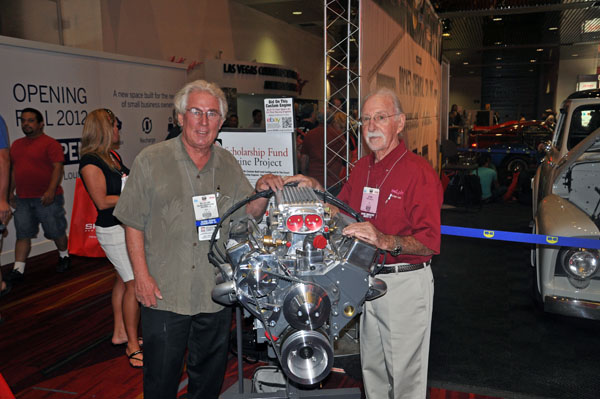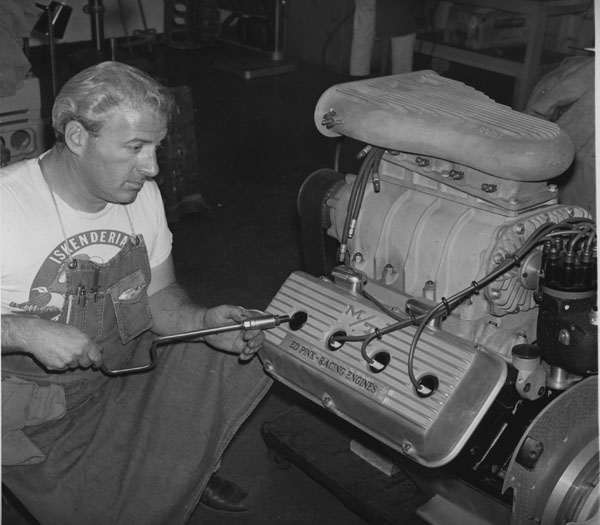2018 SEMA Hall Of Fame Inductee
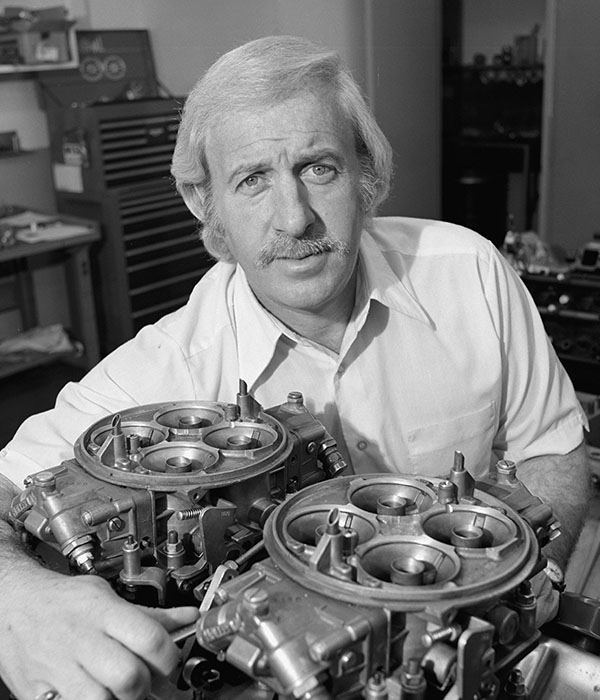
Ed Pink
Ed Pink Racing Engines
Establishing Race-Winning Standards
By Tony Thacker, Courtesy of American Hot Rod Foundation
There is a good reason Ed Pink is known as The Old Master: The man’s command over automotive engineering is legendary and in a league of its own. Engines and high performance have been in his blood right from the start. He didn’t have his first car 24 hours before he had the engine out and apart.
When he was about 16, Pink met Lou Baney. They became instant friends, and Pink eventually went to work for Baney after school during the week and on Saturdays. At the time, Baney had a Golden Eagle gas station, a garage and a speed shop called Hot Rod Heaven. Pink was Baney’s only employee, and he did whatever Baney said; after all, he was on a huge learning curve.
A lot of the legends of hot rodding such as Ed Iskenderian were there bench racing on Saturdays. Pink was also a member of the Russetta Coupes Club that raced at El Mirage Dry Lake, and he got to be fast friends with Fran Hernandez, Bobby Meeks and Don Towle, who all worked at Edelbrock, and also with Vic Edelbrock himself. He had the best in mentors and teachers anybody could ever want, and they became lifelong friends.
Ed Pink
At the time, Pink was working only part time for Baney and most of the time for his dad in his paint store. The Korean War was on, and Pink was drafted into the Army. He ended up in the 25th Infantry Division in Korea.
“Afterward, I was trying to figure out what I wanted to do,” Pink said. “I went to work as a mechanic for Louie Senter at Ansen Engineering. Then my friend Jack Landrum and I decided to open a little garage and Richfield gas station in 1954. We called it Pinkland—a combination of Pink and Landrum. Jack helped me run a ’34 Coupe at El Mirage, but the partnership just wasn’t successful. Neither one of us had any business experience, but it was something we tried together, and it didn’t work. We remained friends until the day Jack died.”
After Pinkland, Pink went to work for Frank Baron of Tattersfield-Baron fame, but he knew that wasn’t what he wanted to do, so he opened another Richfield station and garage. He soon realized that repairing stockers was not what he wanted to do either, so he moved on to Eddie Meyer Engineering.
“Eddie also had a repair business,” Pink said. “Most of his customers were movie people, and I was his mechanic for whatever he needed done. I learned a lot working there. My mentor there was Eddie’s son Bud, another great learning curve and great friend.”
Again, Pink knew that, as good as the job was at Eddie Meyer Engineering, it wasn’t what he wanted to do with his career, so in 1961, upon an invitation from Tony Nancy, he opened his own shop in Nancy’s Sherman Oaks complex. In addition to Nancy’s upholstery shop, the complex housed Kent Fuller’s chassis shop as well as metal shaper and body builder Wayne Ewing, who shaped A.J. Watson’s Champ Cars and the Greer-Black-Prudhomme dragster.
Ed Pink
Pink couldn’t have found a better home. Initially doing some ignition and cylinder-head work, Pink found himself in the middle of drag city, and his customers included Nancy, “Big John” Mazmanian and “TV Tommy” Ivo, to name but a few.
His main concept was that you first have to make the engine live, and then you make it run faster. His whole outlook was preparation. That was one of the lessons learned from Bobby Meeks that he follows today.
Pink’s attention to detail brought him to the attention of racers beyond the quarter mile. That sport was changing, and drag racers were starting to build their own engines. They only needed Ed for advice, and that was hard to charge for. However, a call came from Bill Eaton at Vel’s Parnelli Jones to say that they were converting a DFV Formula 1 engine to run Indy, and they asked Pink to do some special machine work on some connecting rods for them. He said yes, and that started another great relationship.
After word began to spread about Pink’s talents, Cosworth Engineering asked him to perform similar work for its IndyCar engine program, including building its DFX engines. At the peak of that period, Pink was building engines for half a dozen IndyCar teams, including Tom Sneva’s, which won the 1983 Indy 500. He also did engines for Arie Luyendyk and Tim Richmond, who won rookie of the year honors in their respective years. That kept him busy until the late ’80s, when engine building again shifted in-house.
Where next? Well, why not the 24 Hours of Daytona? Old friend Jim Busby was racing 962 turbo Porsches and wanted Pink to take over his Porsche engine program. Pink agreed, and that was the start of another very successful program.
Busby’s Porsches became the fastest in the field and the ones to beat. Pontiac contacted Pink and wanted him to take over its GTP Sport Car racing-engine program, which featured an all-aluminum five-liter V8 to be raced in a Spice GTP car built in England, and that led to a Trans Am program for Pontiac.
Pink helped develop the Turbo Buick V6 engine for Indy and was the head of the design team for Nissan’s Infinity V8 engine for Indy. He was also heavily involved in midget racing with four-cylinder engines for Ford and Toyota that won a combined 10 USAC National Midget Series championships, and the Ford Silver Crown V8 that won four titles in the USAC National Silver Crown Series—all four in a row.
It was a Nissan Indy engine that gave Pink the toughest time. The cylinder block was 80% developed, and some cylinder heads were somewhat finished. But that was it. Pink had to design the rods, pistons, dry-sump oil pump, and every component to make a complete engine. Turns out, they didn’t have the necessary budget to do the project right. In spite of that, the team did win a race and were in contention at a few others.
“I learned a lot, so it wasn’t all bad,” Pink said. “The biggest thing I learned was what you can do when you don’t know you can’t do it.”
Of all the projects over the years, Pink was the proudest of the Toyota Midget engine.
“All TRD had was a cylinder head and a valve cover, and we designed the complete engine,” Pink said. “The first time out at the one-mile Copper Classic in Phoenix in 2006, it set quick time and won the race with Dave Steel driving. To this day, the Toyota engine is the one to have, as it wins most of the races, plus all of the championship teams are Toyota powered. I’m very proud of that.”
Pink learned a lot over the years doing what he loved. He achieved what he did because he listened and learned and applied what he learned. While he’s won many awards and been inducted into numerous halls of fame, Pink said that his key was to keep focusing on the project in front of him.
“Retirement” is a loose term for Pink, who sold Ed Pink Racing Engines in 2008. He has remained involved in the industry with projects such as donating engines for auction to benefit the SEMA Memorial Scholarship Fund. Today, he still keeps busy at Ed Pink’s Garage in Newbury Park, California, where he and longtime friend Bob Brandt are involved with some very interesting projects.

